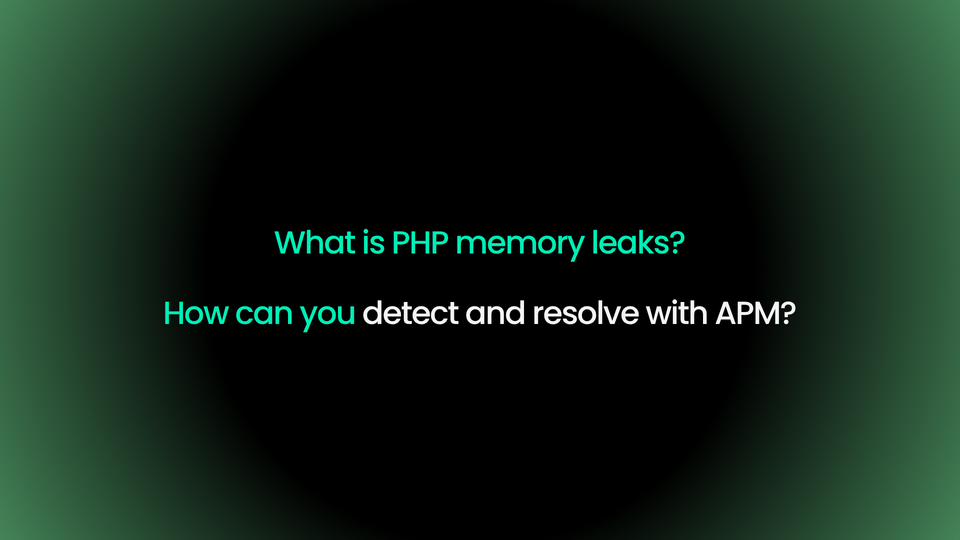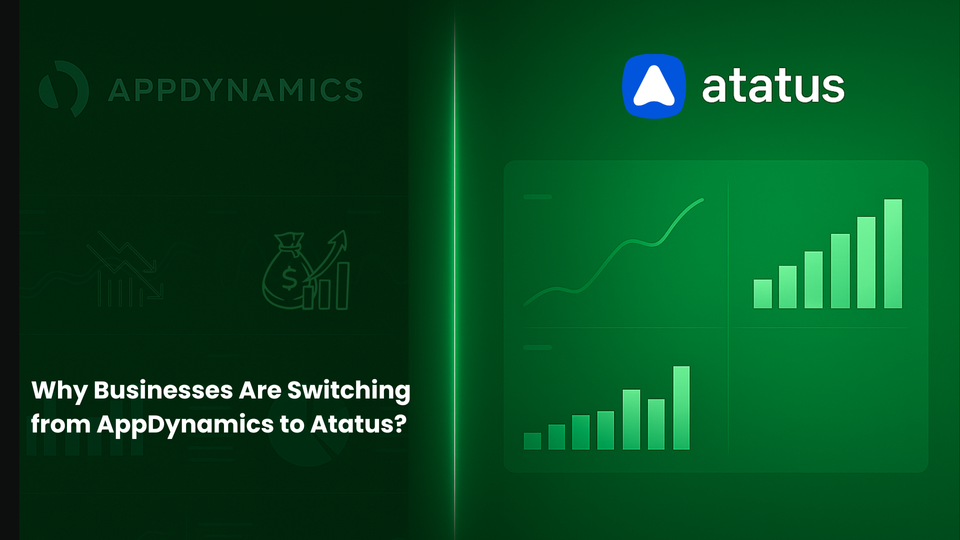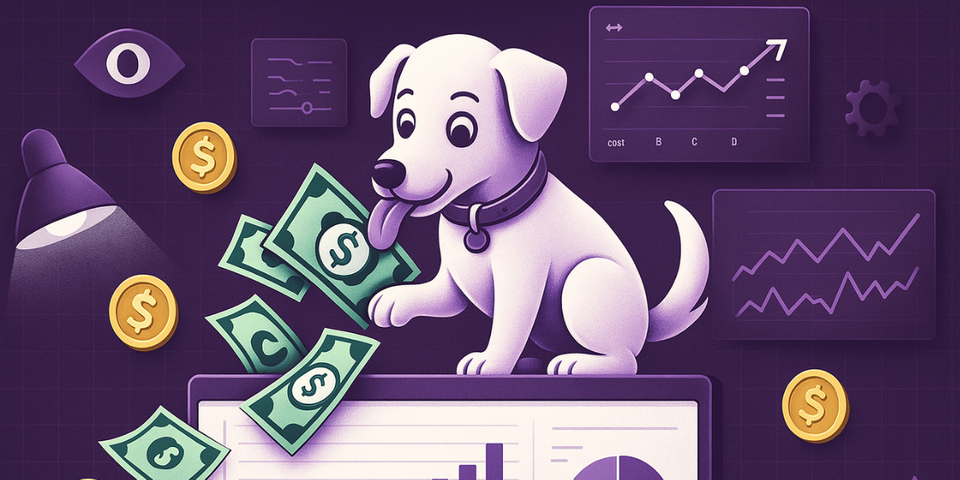What is PHP memory leaks? How can you detect and resolve with APM?
According to the 2025 PHP Trends Report, 31% of developers cited performance bottlenecks as a recurring issue and PHP memory leaks were among the top culprits identified by DevOps teams working with high-traffic applications.
Imagine you're shipping an app that’s humming along smoothly during QA. But weeks after going live, you start noticing creeping latency and irregular job failures. You dig into the logs, tweak some queries, but the issue persists. Additionally, memory usage continues to increase gradually until PHP-FPM workers begin to crash. You’ve just encountered a memory leak, and that doesn’t show up during short test runs but quietly grows under a production load.
For DevOps teams, engineers, developers, and SREs, ignoring PHP memory leaks can lead to severe performance bottlenecks and application downtime. They're a time bomb that's hard to catch, harder to trace, and devastating when left unresolved. Understanding how they happen and what to do about them is no longer optional.
This in-depth guide dives into what PHP memory leaks are, how to spot them, what causes them, and how they impact your application's performance. You’ll also learn practical strategies to fix them and see how Atatus helps to resolve memory issues which makes it a powerful APM solution for your PHP stack.
What's in this guide?
- What is a Memory Leak in PHP?
- What are the common causes of memory leaks in PHP?
- How to Find PHP Memory Leaks?
- How Can You Fix PHP Memory Leaks and How Does APM Help?
- Why Atatus is the Best APM Solution Available in the Market?
- FAQs on PHP Memory Leaks
What is a Memory Leak in PHP?
A memory leak occurs when a PHP script or application continuously consumes memory without releasing it after it is no longer needed. Over time, this leads to growing memory usage, resulting in performance degradation, application crashes, and even server reboots.
Unlike languages like C or C++, PHP is a garbage-collected language, meaning it automatically reclaims memory. However, certain coding patterns, resource mismanagement, or misconfigured extensions can bypass the garbage collector, leading to memory that remains allocated and unfreed.
Memory leaks are particularly dangerous in long-running scripts (e.g., workers or Laravel queues) or persistent environments like PHP-FPM, where scripts don't reset after each request.
What are the common causes of memory leaks in PHP?
PHP Memory leaks don’t always come from bad code. They often stem from unintentional architecture decisions or framework behaviors. Here’s what to watch out for:
1. Unreleased Objects and Circular References
One of the sneakiest causes of memory leaks is circular references. When two or more objects reference each other, PHP’s garbage collector might fail to identify them as disposable. Even though you might think those variables are no longer needed, they continue to occupy memory.
For example, consider two classes referencing each other when one is unset, the other still exists, holding on to the first. This circular dependency keeps the memory in use until the script ends. This issue becomes particularly problematic in long-running scripts or daemon processes where garbage collection doesn’t have a natural reset point.
2. Persistent Connections and Resources
Many developers use persistent database connections or file handlers to improve performance. But if these connections are not properly closed or reused responsibly, they can slowly accumulate in memory.
Think of situations where your application opens a file, database, or external API connection and doesn’t close it properly. Even if the rest of the script finishes, the open resource keeps memory occupied. Multiply this by dozens or hundreds of simultaneous requests, and memory usage will grow uncontrollably.
Additionally, unused image handlers, cURL sessions, and sockets can silently remain active in memory when improperly managed.
3. Incorrect Use of C Extensions
PHP allows the use of third-party or custom extensions written in C for performance-critical applications. However, these extensions often bypass PHP’s internal memory management.
When an extension mishandles memory allocation, either by leaking memory internally or failing to free resources. It creates a scenario that PHP itself cannot detect or clean up. Since these bugs occur at a lower level than PHP code, they are harder to trace, debug, and fix.
Developers may unknowingly introduce these problems when using outdated or poorly maintained extensions, or when writing their own C-based functionality without adequate memory safety practices.
4. Unoptimized Data Structures and Algorithms
Not all memory issues are caused by bugs, some stem from poor design decisions. PHP applications that use memory-intensive operations without safeguards are vulnerable to memory bloat.
For example, loading a massive dataset into memory instead of processing it in chunks, or holding on to large arrays or deeply nested data structures throughout the request lifecycle, can lead to exponential memory usage.
Even caching mechanisms can backfire if not implemented properly. Caching large result sets in memory without any logic for expiration or pruning can cause memory to grow uncontrollably with each request.
The worst part? These problems often go unnoticed in dev environments but explode in production, especially under high load.
How to Find PHP Memory Leaks?
Before fixing anything, you need to know whether a memory leak exists and where it’s happening.
Key techniques to detect PHP memory leaks:
- Use
memory_get_usage()andmemory_get_peak_usage()in strategic parts of your code. - Profile your application with tools like Atatus PHP application performance monitoring to monitor memory usage patterns.
- Check logs and system metrics. Look for increasing memory usage in your PHP-FPM processes or Apache workers.
- Set alerts for unusually high memory consumption using an observability platform.
- Finding the source often involves narrowing down which parts of your application show abnormal memory growth over time.
How Can You Fix PHP Memory Leaks and How Does APM Help?
Solving PHP memory leaks is about understanding where and why your application is bleeding memory. The biggest challenge? These leaks often go unnoticed until performance tanks or the system crashes.
That’s where PHP Application Performance Monitoring (APM) tools come in. They don’t just alert you after things go wrong; they help you track down the root cause of memory issues while your app is running. Here’s how PHP APM solutions play a pivotal role in mitigating PHP memory leaks:
| Problem Area | Description | How APM Helps? |
|---|---|---|
| Proper Variable Management | Variables not explicitly unset can accumulate and exhaust memory in long-running scripts. | APM tools track memory usage per request/function, highlighting areas with poor memory cleanup. |
| Managing Persistent Resources | Open file handlers, database connections, or sockets consume memory across requests. | APM tools correlate memory usage with services/functions, exposing mismanaged resource patterns. |
| Breaking Circular References | Mutual references between objects prevent PHP's garbage collector from releasing memory. | APM detects memory growth trends and unreleased allocations, helping identify circular references. |
| Memory Profiling and Monitoring | Without monitoring, leaks can persist unnoticed across deployments and traffic spikes. | APM provides real-time memory trends, alerts on spikes, and prevents production downtime. |
| Code Optimization and Architecture | Inefficient algorithms, unbounded loops, or bloated libraries increase memory usage. | APM highlights memory-heavy functions and slow operations, guiding optimization efforts. |
Why Atatus is the Best APM Solution Available in the Market?
PHP memory leaks are hard to catch. They’re subtle, often masked under layers of slow degradation, and rarely cause instant failures. But their long-term impact on performance, scalability, and user experience is massive. That’s why relying on logs and manual debugging alone just doesn’t cut it anymore.
Atatus steps in where traditional tools fall short. It gives your team full visibility into your PHP application’s behavior while your system is running in real time.
Here’s why teams trust Atatus:
- End-to-End Visibility Across PHP Stack: From web requests and database queries to memory usage and background jobs, Atatus connects all the dots. You’ll know how every part of your stack contributes to memory usage and performance bottlenecks.
- Real-Time Memory Profiling: Identify slow memory leaks before they escalate. Atatus tracks memory growth trends and flags endpoints or functions that are growing suspiciously even if they don’t crash.
- Zero Configuration Setup: Get started in minutes with easy agent installation. No complex overhead. No delays in seeing data.
- Actionable Insights, Not Just Data: Atatus doesn’t flood you with noise. You get root cause analysis, anomaly detection, and context-rich insights that help developers and DevOps teams fix issues fast.
- Correlated Metrics, Traces, and Logs: Memory leaks rarely happen in isolation. With Atatus, you can correlate memory issues with error rates, slow database calls, or CPU spikes.
- Built for High-Performance Teams: Whether you’re a startup scaling fast or an enterprise with complex architecture, Atatus gives your engineers the tools to build and maintain reliable, high-performing applications.
Make Your PHP Apps Perform Like They Should!
Memory leaks are a silent killer. They eat away at your infrastructure, slow your app down, and ultimately affect your customer experience. You can’t afford to ignore them and you don’t have to.
With Atatus, you get more than visibility. You get confidence that your app is healthy, your team is in control, and your users are getting the experience they expect.
👉 Request a Demo or Start Monitoring for Free and see how Atatus transforms the way you handle performance in PHP.
FAQs on PHP Memory Leaks
Can PHP memory leaks go undetected for a long time?
Yes. In long-running PHP applications, especially those using daemons or workers, memory leaks can build up silently over time, causing unexpected performance degradation.
Do APM tools help detect PHP memory leaks early?
Absolutely. APM solutions track memory usage over time, correlate it with code-level transactions, and alert you when abnormal memory behavior is detected which allows early intervention.
What metrics should I monitor to detect PHP memory leaks?
Track metrics such as memory usage per request, memory growth trends, garbage collection cycles, and peak memory consumption. PHP APM tools often visualize these trends clearly.
Can memory leaks in PHP affect user experience?
Yes. As server resources are drained, page loads slow down, timeouts increase, and users experience lag or errors especially under peak traffic.
Is PHP memory leak prevention part of performance monitoring strategies?
Yes. Preventing and detecting memory leaks is a core aspect of PHP application performance monitoring tools to provide real-time visibility and long-term trends to mitigate these issues proactively.
#1 Solution for Logs, Traces & Metrics
APM
Kubernetes
Logs
Synthetics
RUM
Serverless
Security
More





